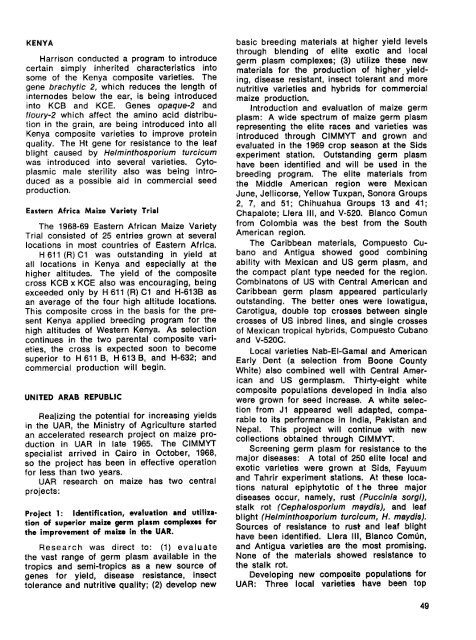REPORT - Search CIMMYT repository
REPORT - Search CIMMYT repository
REPORT - Search CIMMYT repository
You also want an ePaper? Increase the reach of your titles
YUMPU automatically turns print PDFs into web optimized ePapers that Google loves.
KENYA<br />
Harrison conducted a program to introduce<br />
certain simply inherited characteristics into<br />
some of the Kenya composite varieties. The<br />
gene brachytic 2, which reduces the length of<br />
internodes below the ear, is being introduced<br />
into KCB and KCE. Genes opaque-2 and<br />
floury-2 which affect the amino acid distribution<br />
in the grain, are being introduced into all<br />
Kenya composite varieties to improve protein<br />
quality. The Ht gene for resistance to the leaf<br />
blight caused by Helminthosporium turcicum<br />
was introduced into several varieties. Cytoplasmic<br />
male sterility also was being introduced<br />
as a possible aid in commercial seed<br />
production.<br />
Eastern Africa Maize Variety Trial<br />
The 1968-69 Eastern African Maize Variety<br />
Trial consisted of 25 entries grown at several<br />
locations in most countries of Eastern Africa.<br />
H 611 (R) C1 was outstanding in yield at<br />
all locations in Kenya and especially at the<br />
higher altitudes. The yield of the composite<br />
cross KCB x KCE also was encouraging, being<br />
exceeded only by H 611 (R) C1 and H-613B as<br />
an average of the four high altitude locations.<br />
This composite cross in the basis for the present<br />
Kenya applied breeding program for the<br />
high altitudes of Western Kenya. As selection<br />
continues in the two parental composite varieties,<br />
the cross is expected soon to become<br />
su perior to H 611 B, H 613 B, and H-632; and<br />
commercial production will begin.<br />
UNITED ARAB REPUBLIC<br />
Realizing the potential for increasing yields<br />
in the UAR, the Ministry of Agriculture started<br />
an accelerated research project on maize production<br />
in UAR in late 1965. The <strong>CIMMYT</strong><br />
specialist arrived in Cairo in October, 1968,<br />
so the project has been in effective operation<br />
for less than two years.<br />
UAR research on maize has two central<br />
projects:<br />
Project 1: Identification, evaluation and utilization<br />
of superior maize germ plasm complexes for<br />
the improvement of maize in the UAR.<br />
Research was direct to: (1) evaluate<br />
the vast range of germ plasm available in the<br />
tropics and semi-tropics as a new source of<br />
genes for yield, disease resistance, insect<br />
tolerance and nutritive quality; (2) develop new<br />
basic breeding materials at higher yield levels<br />
through blending of elite exotic and local<br />
germ plasm complexes; (3) utilize these new<br />
materials for the production of higher. yielding,<br />
disease resistant, insect tolerant and more<br />
nutritive varieties and hybrids for commercial<br />
maize production.<br />
Introduction and evaluation of maize germ<br />
plasm: A wide spectrum of maize germ plasm<br />
representing the elite races and varieties was<br />
introduced through <strong>CIMMYT</strong> and grown and<br />
evaluated in the 1969 crop season at the Sids<br />
experiment station. Outstanding germ plasm<br />
have been identified and will be used in the<br />
breeding program. The elite materials from<br />
the Middle American region were Mexican<br />
June, Jellicorse, Yellow Tuxpan, Sonora Groups<br />
2, 7, and 51; Chihuahua Groups 13 and 41;<br />
Chapalote; L1era III, and V-520. Blanco Comun<br />
from Colombia was the best from the South<br />
American region.<br />
The Caribbean materials, Compuesto Cubano<br />
and Antigua showed good combining<br />
ability with Mexican and US germ plasm, and<br />
the compact plant type needed for the region.<br />
Combinatons of US with Central American and<br />
Caribbean germ plasm appeared particularly<br />
outstanding. The better ones were lowatigua,<br />
Carotigua, double top crosses between single<br />
crosses of US inbred lines, and single crosses<br />
of Mexican tropical hybrids, Compuesto Cubano<br />
and V-520C.<br />
Local varieties Nab-EI-Gamal and American<br />
Early Dent (a selection from Boone County<br />
White) also combined well with Central American<br />
and US germplasm. Thirty-eight white<br />
composite populations developed in India also<br />
were grown for seed increase. A white selection<br />
from J1 appeared well adapted, comparable<br />
to its performance in India, Pakistan and<br />
Nepal. This project will continue with new<br />
collections obtained through <strong>CIMMYT</strong>.<br />
Screening germ plasm for resistance to the<br />
major diseases: A total of 250 elite local and<br />
exotic varieties were grown at Sids, Fayuum<br />
and Tahrir experiment stations. At these locations<br />
natural epiphytotic of t he three major<br />
diseases occur, namely, rust (Puccinia sorgi),<br />
stalk rot (Cephalosporium maydis), and leaf<br />
blight (Helminthosporium turcicum, H. maydis).<br />
Sources of resistance to rust and leaf blight<br />
have been identified. L1era III, Blanco Comun,<br />
and Antigua varieties are the most promising.<br />
None of the materials showed resistance to<br />
the stal k rot.<br />
Developing new composite populations for<br />
UAR: Three local varieties have been top<br />
49

















